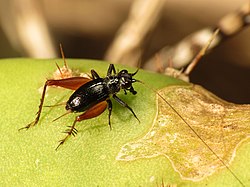| Trigonidium cicindeloides | |
|---|---|
 | |
| Trigonidium cicindeloides | |
| Scientific classification | |
| Kingdom: | Animalia |
| Phylum: | Arthropoda |
| Class: | Insecta |
| Order: | Orthoptera |
| Suborder: | Ensifera |
| Family: | Trigonidiidae |
| Subfamily: | Trigonidiinae |
| Tribe: | Trigonidiini |
| Genus: | Trigonidium |
| Species: | T. cicindeloides |
| Binomial name | |
| Trigonidium cicindeloides Rambur, 1838 | |
| Synonyms [2] | |
| |
Trigonidium cicindeloides is a species of sword-tail cricket widespread in Africa, southern Europe, Asia, and Arabia. [1] During mating season males make a sound created by vibrating the last two joints of their maxillary palpi. This is either to attract females for mating or to drive off other males. [3]
